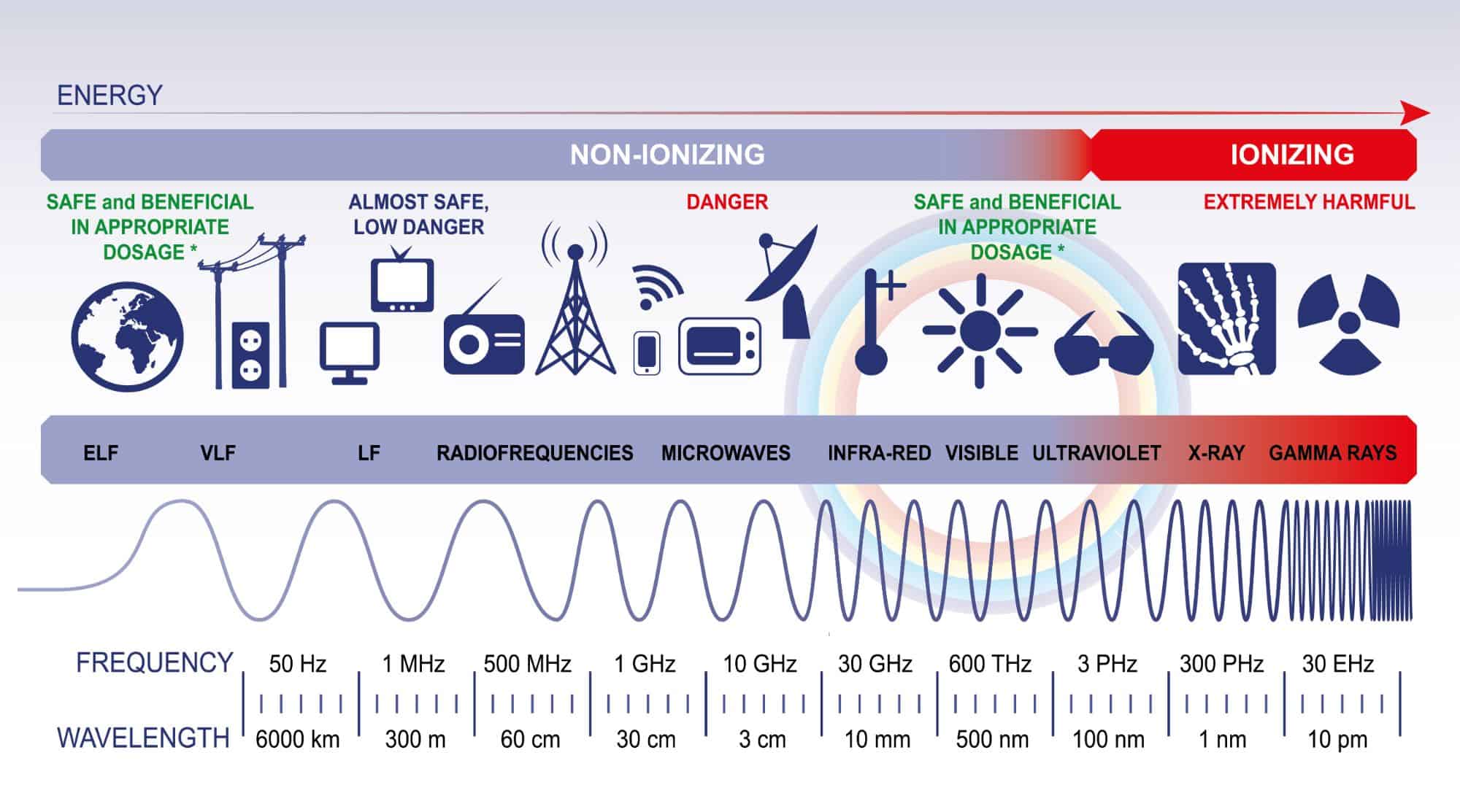What are EMFs?
electromagnetic fields

In a few decades, we have gone from our primary EMF exposure being from natural sources, lower-frequency AC electric and magnetic fields, radio waves, and some microwaves to a much more extensive range of radio frequencies saturating our streets and our move towards ‘smart’ homes.
From the low-frequency electric and magnetic fields emitted by our appliances to the high-frequency radio waves and microwaves used in wireless communication and 5G technology.

Ionising and non-ionising radiation
EMFs are generally classified into two categories: non-ionising and ionising radiation. While
Ionising radiation is well known to be harmful. Building Biologists and EMF Testing Technicians that assess EMF hazards based on health-based standards (not industry standards) consider the health effects of all electromagnetic fields based on the reports of adverse health effects in the scientific evidence. Read more on the adverse health effects here.
Non-ionising radiation
Non-ionising radiation includes alternating current (AC) and direct current (DC) from electric and magnetic Fields. Australia’s distribution system uses 50Hz AC electricity with common sources of electric and magnetic fields from power lines, high voltage transmission lines, Extremely Low Frequency (ELF), Very Low Frequency (VLF), and Low Frequency (LF) radiation is 3Hz to 3000Hz (3KHz). Radiofrequency radiation (RF) radiation: 300 Hz to 300GHz, which includes microwaves and radio waves used in wireless communication technologies such as cell phones, Wi-Fi, and Bluetooth. 5G (fifth generation) technology includes millimetre (mm) waves that are part of the radio wave spectrum and operate between 24 and 30Ghz–300Ghz in frequency. Presently, the most popular form of 5G is within the mid to low-band range, ranging from 700MHz-3.6GHz; and with the launch of mm-wave infrastructure not far off.
Infrared radiation is included in non-ionising radiation from 300 GHz to 400 THz, including heat radiation from warm objects and visible light 400 THz to 800 THz, which consists of the colours of the rainbow that our eyes can see.
Non-ionising radiation was classified as possibly carcinogenic by the International Agency for Research on Cancer (IARC) a division of the world health organisation, in 2011.
There is evidence that non-ionising radiation has the potential to cause oxidative stress and produce secondary damage to DNA.
However, they can be used in beneficial therapies such as bone healing, light therapies etc., so we know that they can have an impact on the body.
Ionising radiation
Understanding the different frequencies of EMFs
Understanding the properties of different EMFs on the electromagnetic spectrum is imperative to understanding our EMF exposure and potential risks to the human body.
Understanding the difference between EMFs helps us to understand:
- The associated risks to human health and potential health hazards
- The EMF source and frequency determine the meter required to measure it.
- Shielding solutions offer varying degrees of EMF protection at different frequencies.
Understanding how they work to limit EMF exposure will help ensure effectiveness and avoid creating other risks in the shielding process.
Each EMF field/hazard are measured with different equipment calibrated to measure the specific range of the spectrum. The electric and magnetic fields have yet to be coupled at lower frequencies, so they can be measured independently.
For example, different EMF meters are used for assessing electric and magnetic fields from high voltage power lines than those we use to measure electromagnetic radiation (EMR/RF) transmitted by mobile phones and towers.
As well as requiring different EMF meters and detectors to measure high and low frequencies, other high-frequency antennas may be required depending on the RF source and frequency you wish to measure. Most radiofrequency and microwave sources that impact us fall between the range of 100MHz-5GHz (3G, 4G, 5G-3.5GHz mid-band, Bluetooth, WIFI, etc.), with sources above 10GHz becoming more common, such as 5G millimetre waves, satellites, some NBN services etc. For this reason, it is essential to understand the range of the EMF meters used to assess your EMF exposure.
It is also important to note that materials designed to block or shield RF wireless transmissions do not also block magnetic fields (unless very specialised materials).
Due to the different characteristics of EMFs on the spectrum, they also interact with our bodies differently. To learn more about the health effects at different frequencies, go here.
EMF hazards that we assess:
- AC & DC magnetic fields
- AC electric fields
- Dirty electricity
- Electrical Light spectrum and flicker
- Microcurrent-low-level currents
- Radiofrequency Radiation and 5G
To read more about EMF hazards, click on the button below.






